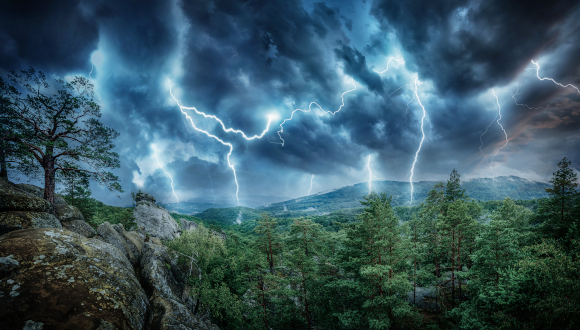Deforestation may be decreasing frequency of thunderstorms in South America, TAU research says

Change could affect amount of oxygen forests release into the atmosphere
Support this researchResearchers from Tel Aviv University (TAU) have determined that the number of thunderstorms in the Amazon basin has decreased significantly and the area over which they occur has shrunk.
According to the researchers, this is a surprising finding. “In most areas of the world, global warming has resulted in an increase in the number of thunderstorms, but in this study we discovered that precisely in those areas where deforestation has increased the number of storms actually decreased, even with rising temperatures,” they report. “These findings are worrying because a decrease in the amount of storms leads to a decrease in the amount of rain, which in turn causes further damage to the forests. This is a dangerous feedback loop, which could severely damage the forests that provide the earth with a significant portion of the oxygen in the atmosphere and absorb a large portion of the carbon dioxide emitted by us into the atmosphere.”
The research was led by Professor Colin Price and graduate student Raam Beckenshtein from the Department of Geophysics at the Porter School of the Environment and Earth Sciences at TAU. The research was published on June 24, 2023, in the Quarterly Journal of the Royal Meteorological Society (QJRMS).
“The Amazon tropical rainforests are the largest in the world and play a critical role in regulating the earth’s climate,” Professor Price explains. “These forests are often called ‘the lungs of the earth,’ because through the process of photosynthesis the forests produce a significant portion of the oxygen in the atmosphere and absorb a large amount of its carbon dioxide, a greenhouse gas that makes a significant contribution to climate change. In addition, the rainforests themselves produce their own rain: the trees emit water vapor via evaporation into the air that eventually condenses and forms clouds and rain above the rainforests. Hence, the forests influence the local and regional rainfall.”
The researchers point out that these important processes are currently in danger due to the extensive activity of deforestation in the Amazon, including cutting down trees for wood and clearing areas for agriculture, infrastructure development, and mining. In fact, in the 30 years between 1990 and 2020, forests whose total area is larger than the entire continent of Europe were destroyed in the Amazon basin.
In this study, the first of its kind, the researchers sought to track changes in the extent of thunderstorms in the Amazon basin in recent decades. In the absence of thunderstorm data from the Amazon, the researchers built an empirical model based on climatic parameters from the European Center ERA5, which has collected data on global climate since 1940, along with thunderstorm data collected through a worldwide network of lightning detection sensors called the Worldwide Lightning Location Network (WWLLN).
“Here at TAU, on the roof of the geophysics building, we have one of the sensors that picks up radio waves from thunderstorms that occur in our region, in Africa, India, and even South America,” Prof. Price says. “Cross-referencing the information from the various stations results in an accurate determination of the location and time of each lightning strike, and thus a global map of lightning strikes over time is obtained.”
“In this study we examined trends in thunderstorm activity in the Amazon basin in recent decades,” Professor Price says. “We expected to find an increase in the number of storms due to global warming, as has been observed in many regions of the world, but to our surprise we found the opposite trend: a decrease of 8% over 40 years. Further analysis revealed that most of the decrease was observed precisely in those areas where the rainforests were replaced by agriculture or other human activity.
“The decrease can be explained by the fact that the absence of the forests significantly reduced the moisture in the air, which is the source of energy and moisture needed for the formation of thunderstorms. The result is fewer thunderstorms, fewer clouds, less rain, and consequently less growth of the forest. This creates a dangerous feedback loop that can cause the forests to dry out and significantly reduce the vital contribution of the ‘Lungs of the Earth’ to oxygen production and carbon dioxide absorption.”